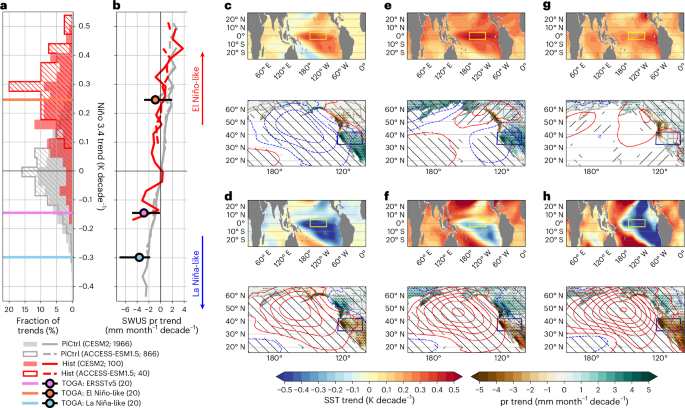Report on Urban Greenhouse Gas Emissions from Meat Consumption and Alignment with Sustainable Development Goals
Introduction: Urban Consumption and Climate Action
A recent study published in Nature Climate Change provides a critical analysis of greenhouse gas (GHG) emissions generated by urban populations in the United States. The research, covering over 3,500 cities, establishes a direct and significant link between urban dietary habits, specifically meat consumption, and progress towards key Sustainable Development Goals (SDGs), particularly SDG 13 (Climate Action) and SDG 11 (Sustainable Cities and Communities). The findings highlight that emissions from meat consumption are a major component of a city’s carbon footprint, necessitating their inclusion in urban sustainability strategies.
Key Findings: A Comparative Analysis of Urban Emissions
The study reveals that the climate impact of meat consumption in U.S. cities is comparable to that of residential energy use, a sector that traditionally receives more attention in decarbonization efforts. This underscores the importance of addressing consumption patterns as a core component of sustainable urban development.
- Meat Consumption Emissions: The total climate impact from beef, chicken, and pork consumption in U.S. cities is 329 megatons of CO2 equivalent annually.
- Residential Energy Emissions: The total emissions from fossil fuels used for lighting, heating, cooling, and powering appliances in U.S. city homes amount to 334 megatons of CO2 equivalent annually.
This parity indicates a significant, yet often overlooked, opportunity for climate mitigation that directly supports SDG 12 (Responsible Consumption and Production).
Challenges in Addressing Food-Related Emissions
The report identifies a “spatial disconnect” as a primary barrier to tackling food-related emissions within urban policy. This challenge impedes the integration of food systems into strategies for achieving SDG 11.
- Abstract Supply Chains: Urban consumers and policymakers are often detached from the production processes of their food, as most meat is produced outside city limits. This “out of sight, out of mind” effect makes it difficult to conceptualize and address the associated environmental impacts.
- Policy Focus: It is often perceived as easier for city planners and policymakers to focus on modifying physical infrastructure within their direct control, rather than influencing complex, global food supply chains.
Proposed Mitigation Strategies and SDG Alignment
The study modeled several consumer-level interventions to reduce the climate impact of urban diets, offering actionable pathways toward SDG 13 (Climate Action) and SDG 12 (Responsible Consumption and Production).
Dietary Substitution as a Climate Mitigation Tool
The most impactful strategies involve substituting high-emission meats with lower-emission alternatives. These changes can be implemented more swiftly than many infrastructure-based decarbonization projects.
- Substituting Half of Beef with Chicken: This action would reduce associated emissions by 33%.
- Substituting Half of Beef with a Pork/Chicken Mix: This would result in a 29% reduction in emissions.
- Adopting a “Meatless Monday” Approach: Forgoing meat one day per week offers a 14% reduction in emissions.
The study’s authors suggest that promoting substitution is a more viable strategy than advocating for complete meat elimination, as it presents a more accessible path for widespread consumer adoption.
Broader Implications and Challenges for Sustainable Development
While dietary substitution offers a clear benefit for SDG 13, the report acknowledges potential negative trade-offs with other Sustainable Development Goals.
Conflicts with Other Environmental and Ethical Goals
A holistic approach to sustainability requires considering the wider impacts of shifting consumption from beef to other animal proteins.
- SDG 6 (Clean Water and Sanitation): Increased production of pork and chicken is linked to higher risks of acidification and eutrophication, which degrade water quality and soil health. Documented cases of water pollution from pork and chicken industries highlight this significant environmental consequence.
- SDG 15 (Life on Land): The “small body problem” is a key ethical concern, as replacing one large animal (a cow) requires raising and slaughtering many more smaller animals (chickens), raising significant animal welfare issues.
- SDG 12 (Responsible Consumption and Production): A critique of consumer-focused solutions is that they fail to place responsibility on large-scale livestock producers to transition toward more sustainable practices.
Conclusion: Integrating Food Systems into Urban Climate Policy
The research provides valuable, granular data that empowers individual cities to understand and address their dietary emissions, a critical step for advancing SDG 11 (Sustainable Cities and Communities). The findings confirm that emissions from food production, particularly from enteric fermentation and manure management in animal agriculture, far outweigh emissions from transportation (“food miles”).
To effectively pursue SDG 13 (Climate Action), urban sustainability strategies must expand to include consumption-based emissions from food. By highlighting that the “hoofprint” of meat consumption is as significant as the footprint of home energy, this report calls for a broader dialogue on decarbonizing urban food systems. Future policies should promote sustainable dietary shifts while carefully managing trade-offs to ensure balanced progress across all relevant Sustainable Development Goals.
Analysis of Sustainable Development Goals in the Article
1. Which SDGs are addressed or connected to the issues highlighted in the article?
-
SDG 13: Climate Action
- The entire article is centered on the climate impact of meat consumption, specifically the “greenhouse gas emissions” produced by urban dwellers. It directly compares these emissions to those from powering homes, framing the issue as a critical component of climate change mitigation. The article quantifies the climate impact in “megatons of CO2 equivalent,” directly linking food systems to global climate goals.
-
SDG 12: Responsible Consumption and Production
- The article analyzes the “food-system supply-chain” and the consumption patterns of city dwellers. It explores strategies to make consumption more sustainable, such as “reducing food waste,” substituting high-emission products (beef) with lower-emission ones (chicken), and reducing overall meat consumption (“Meatless Mondays”). This directly addresses the need for more sustainable patterns of consumption and production.
-
SDG 11: Sustainable Cities and Communities
- The study’s focus is explicitly on “over 3,500 U.S. cities” and the emissions generated by their inhabitants. It discusses the challenges for urban policymakers in addressing food-related emissions and how a city’s “carbon footprint” is significantly driven by dietary choices. The goal is to integrate these findings into “urban sustainability strategies.”
-
SDG 14: Life Below Water
- The article points out the negative environmental consequences of shifting from beef to pork and chicken production, specifically mentioning “eutrophication, which degrades water quality.” It cites “well-documented cases of water pollution from the pork industry” and the pollution of the “River Wye” from chicken production, highlighting how land-based agricultural activities impact aquatic ecosystems.
-
SDG 15: Life on Land
- The analysis extends to the impact on terrestrial ecosystems. The article notes that pork and chicken production lead to “higher risks of acidification,” which “degrade[s] soil health.” This connects intensive livestock farming to the degradation of land and inland water ecosystems, as seen in the pollution of rivers.
2. What specific targets under those SDGs can be identified based on the article’s content?
-
Under SDG 13 (Climate Action):
- Target 13.2: Integrate climate change measures into policies, strategies and planning. The article highlights the challenge for policymakers to include food systems in “urban sustainability strategies,” suggesting that the study’s findings should inform these plans.
- Target 13.3: Improve education, awareness-raising and human and institutional capacity on climate change mitigation. The article and the study it describes serve to raise awareness among consumers and policymakers about the “hoofprint” of meat consumption, aiming to start a “broader dialogue” on how to tackle it.
-
Under SDG 12 (Responsible Consumption and Production):
- Target 12.3: By 2030, halve per capita global food waste at the retail and consumer levels. The article explicitly mentions that the study “modeled a number of ways to shrink urban food-related emissions, including reducing food waste.”
- Target 12.8: By 2030, ensure that people everywhere have the relevant information and awareness for sustainable development and lifestyles. The study provides detailed information to consumers about how their dietary choices—such as swapping beef for chicken or skipping meat once a week—directly impact climate emissions.
-
Under SDG 11 (Sustainable Cities and Communities):
- Target 11.6: By 2030, reduce the adverse per capita environmental impact of cities. The study directly measures the per capita climate impact of urban food consumption, finding that “the total climate impact for U.S. cities is 329 megatons of CO2 equivalent” from meat alone, thereby providing a baseline for reduction efforts.
-
Under SDG 14 (Life Below Water):
- Target 14.1: By 2025, prevent and significantly reduce marine pollution of all kinds, in particular from land-based activities, including nutrient pollution. The article’s discussion of “eutrophication” and “water pollution from the pork industry” directly relates to nutrient pollution from land-based agriculture that harms aquatic ecosystems.
-
Under SDG 15 (Life on Land):
- Target 15.3: By 2030, combat desertification, restore degraded land and soil… and strive to achieve a land degradation-neutral world. The article identifies “acidification” from pork and chicken production as a factor that “degrade[s] water quality and soil health,” connecting it to the broader issue of land degradation.
3. Are there any indicators mentioned or implied in the article that can be used to measure progress towards the identified targets?
- Greenhouse Gas Emissions from Food Consumption: The article provides a direct, quantifiable indicator. It states the emissions from meat consumption in U.S. cities are “329 megatons of CO2 equivalent.” This can be tracked over time to measure progress in reducing the climate impact of urban diets.
- Percentage Reduction in Emissions from Dietary Changes: The article offers specific metrics for the effectiveness of different strategies. For example, swapping half of beef for chicken would “reduce emissions by 33 percent,” while not eating meat one day a week offers a “14 percent reduction.” These percentages are clear indicators of progress.
- Per Capita Meat Consumption (by type): While not stated as a formal indicator, the study’s methodology of linking “livestock- and poultry-producing counties to… meat-consuming cities” implies that tracking the per capita consumption of beef, pork, and chicken is a key metric for assessing the impact of dietary shifts.
- Levels of Water and Soil Pollution: The article implies the existence of indicators for environmental degradation by mentioning “acidification and eutrophication” as measurable consequences and citing “well-documented cases of water pollution.” These environmental quality metrics can be used to track the broader impacts of the food system.
4. Summary Table of SDGs, Targets, and Indicators
| SDGs, Targets and Indicators | Targets | Indicators |
|---|---|---|
| SDG 13: Climate Action | 13.2: Integrate climate change measures into policies and planning. | Greenhouse gas emissions from urban food consumption (measured in megatons of CO2 equivalent). |
| SDG 12: Responsible Consumption and Production | 12.3: Halve per capita food waste. 12.8: Ensure people have information for sustainable lifestyles. |
Percentage reduction in emissions from dietary changes (e.g., 33% reduction from swapping beef for chicken). Amount of food waste generated and reduced. |
| SDG 11: Sustainable Cities and Communities | 11.6: Reduce the adverse per capita environmental impact of cities. | Per capita carbon footprint from food consumption in urban areas. |
| SDG 14: Life Below Water | 14.1: Reduce marine pollution from land-based activities. | Levels of eutrophication in waterways caused by agricultural runoff. |
| SDG 15: Life on Land | 15.3: Combat land degradation and restore degraded soil. | Levels of soil acidification linked to livestock production. |
Source: sentientmedia.org







